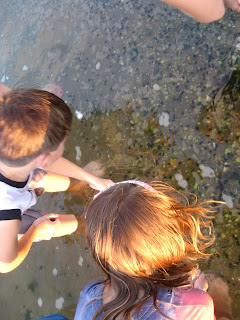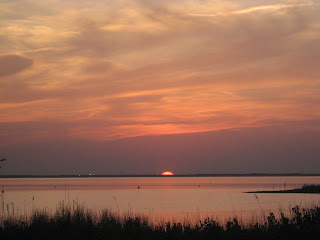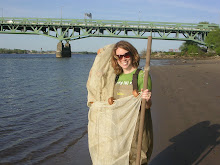
Last night was the Littoral Society’s second Family Night of the summer. On Thursday nights in July and August families meet the American Littoral Society at building 18. They start the night off with a bit of history about ALS from Frank, a board member who has been to almost every family night since we started doing them many years ago. Having been around since 1961, the American Littoral Society has many great traditions, and you get a real sense of history and camaraderie when participating in events like family night.
every family night since we started doing them many years ago. Having been around since 1961, the American Littoral Society has many great traditions, and you get a real sense of history and camaraderie when participating in events like family night.
Next we break out the microscopes and curious kids (and parents) take a look at the tiny organisms often overlooked in our coastal waters. They find that the water is teaming with plankton. We also bring out some of the baby horseshoe crabs we have been raising, another educational project in the works.
plankton. We also bring out some of the baby horseshoe crabs we have been raising, another educational project in the works.
Then the real fun begins. We head down to horseshoe cove with buckets, kiddy pools, and our 40 foot seine net for a close encounter with what’s just below the surface of the water. Last night, all of the kids were eager to help pull the seine net and transfer our catch into the pool for a closer look. We all huddled over the pool examining our catch, ALS staff and parents just as excited as the kids. Our catch last night included a swill of silversides, striped killifish, northern kingfish, comb jellies, blue claw crabs, and grass shrimp. Digging and wading in the tidal pool at horseshoe cove, we were also able to find hermit crabs, mud snails, fiddler crabs, and Asian shore crabs. With each new critter we found, there was a story to tell. That’s what I love most about Family Night, the exchange of stories and thus knowledge.
northern kingfish, comb jellies, blue claw crabs, and grass shrimp. Digging and wading in the tidal pool at horseshoe cove, we were also able to find hermit crabs, mud snails, fiddler crabs, and Asian shore crabs. With each new critter we found, there was a story to tell. That’s what I love most about Family Night, the exchange of stories and thus knowledge.
 As the sun began to set, we had to pack up. As we released the catch, flocks of terns and even a few skimmers came by to check out what we found. I think that they are trained at this point to know that once we pack up there is a feast awaiting them. We all stood back and watched the show before us, terns plummeting into the water and coming up with silversides.
As the sun began to set, we had to pack up. As we released the catch, flocks of terns and even a few skimmers came by to check out what we found. I think that they are trained at this point to know that once we pack up there is a feast awaiting them. We all stood back and watched the show before us, terns plummeting into the water and coming up with silversides.
 every family night since we started doing them many years ago. Having been around since 1961, the American Littoral Society has many great traditions, and you get a real sense of history and camaraderie when participating in events like family night.
every family night since we started doing them many years ago. Having been around since 1961, the American Littoral Society has many great traditions, and you get a real sense of history and camaraderie when participating in events like family night.Next we break out the microscopes and curious kids (and parents) take a look at the tiny organisms often overlooked in our coastal waters. They find that the water is teaming with
 plankton. We also bring out some of the baby horseshoe crabs we have been raising, another educational project in the works.
plankton. We also bring out some of the baby horseshoe crabs we have been raising, another educational project in the works.Then the real fun begins. We head down to horseshoe cove with buckets, kiddy pools, and our 40 foot seine net for a close encounter with what’s just below the surface of the water. Last night, all of the kids were eager to help pull the seine net and transfer our catch into the pool for a closer look. We all huddled over the pool examining our catch, ALS staff and parents just as excited as the kids. Our catch last night included a swill of silversides, striped killifish,
 northern kingfish, comb jellies, blue claw crabs, and grass shrimp. Digging and wading in the tidal pool at horseshoe cove, we were also able to find hermit crabs, mud snails, fiddler crabs, and Asian shore crabs. With each new critter we found, there was a story to tell. That’s what I love most about Family Night, the exchange of stories and thus knowledge.
northern kingfish, comb jellies, blue claw crabs, and grass shrimp. Digging and wading in the tidal pool at horseshoe cove, we were also able to find hermit crabs, mud snails, fiddler crabs, and Asian shore crabs. With each new critter we found, there was a story to tell. That’s what I love most about Family Night, the exchange of stories and thus knowledge. As the sun began to set, we had to pack up. As we released the catch, flocks of terns and even a few skimmers came by to check out what we found. I think that they are trained at this point to know that once we pack up there is a feast awaiting them. We all stood back and watched the show before us, terns plummeting into the water and coming up with silversides.
As the sun began to set, we had to pack up. As we released the catch, flocks of terns and even a few skimmers came by to check out what we found. I think that they are trained at this point to know that once we pack up there is a feast awaiting them. We all stood back and watched the show before us, terns plummeting into the water and coming up with silversides. We all left with sandy feet, smiles on our faces, and hopefully a new love for the coast.
Littorally Yours,
Stevie
Littorally Yours,
Stevie











 The American Littoral Society brings 12 high school students from Camden and Newark out to Sedge Island every year. It’s a small island in Barnegat bay off the coast of Island Beach State Park. The students leave the urban environment for three days and are completely immersed in nature and the serenity of the salt marsh. No phones, no ipods, and nothing to watch at night but the setting sun. The days are spent kayaking, fishing, clamming, and exploring the littoral zone. Students not only learn about the
The American Littoral Society brings 12 high school students from Camden and Newark out to Sedge Island every year. It’s a small island in Barnegat bay off the coast of Island Beach State Park. The students leave the urban environment for three days and are completely immersed in nature and the serenity of the salt marsh. No phones, no ipods, and nothing to watch at night but the setting sun. The days are spent kayaking, fishing, clamming, and exploring the littoral zone. Students not only learn about the 
















